"Your problem is to change the gap which exists between where you are now and the goal you intend to achieve" - Earl Nightingale
Table of Content
Overview
No matter how much we accomplish in life, we would always want to achieve more based on the pedestals of success we have envisaged and the objectives we have set for ourselves. If someone is earning a six-digit salary today, he or she would want to take it further to a seven-digit number in the next few years. Similarly, if a company has been able to capture a local market, it would want to become a Fortune 500 company one fine day. The gist of the matter is that there would always be a certain gap between where we have reached in our lives and where we ultimately want to be. This is where a Gap Analysis comes into the picture.
In this meticulous blog, we present to you an intelligible and detailed description of what a Gap Analysis is, the real purpose behind carrying out a Gap Analysis, and the best practices for conducting it.
Moreover, each vertical of Gap Analysis is supported by practical and realistic examples for convenient and worthwhile comprehension. So, without further ado, let us glance at the definition and construct of Gap Analysis.
What is a Gap Analysis?
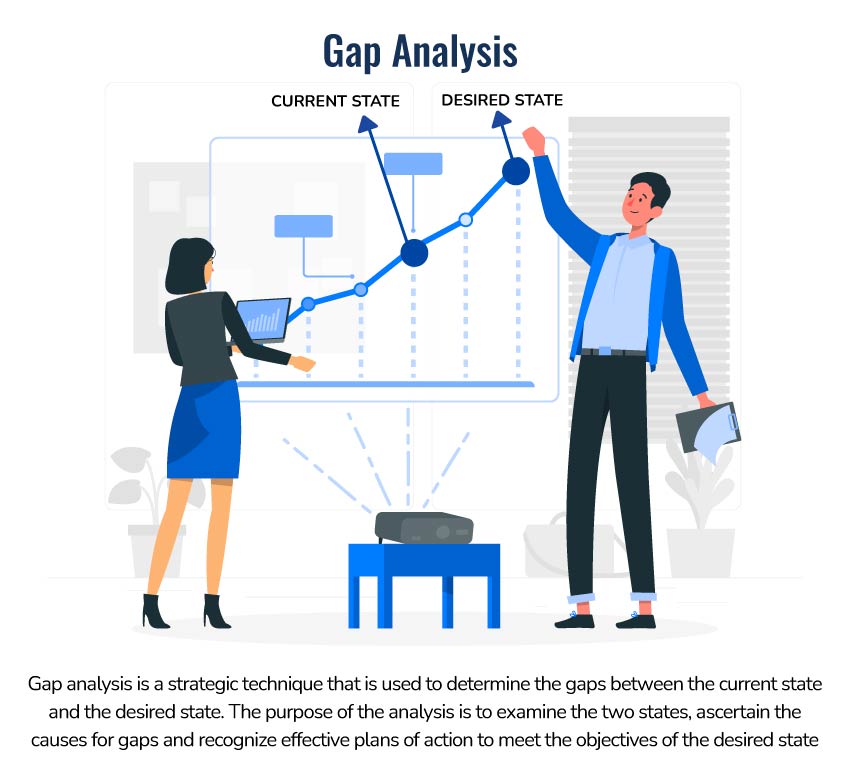
As the name suggests, Gap Analysis is a strategic technique to identify the gaps between the current state and the future vision.
Moreover, a Gap Analysis can be used by individuals, groups, governments, unions, and business organizations to find the differences between the current state and what they have envisaged for the future. Basically, anyone can apply Gap Analysis to find the difference between their current state and the desired state.
In another context, a Gap Analysis technique can be applied to recognizing the deficits in the current state and the desired state in terms of pre-defined objectives. Again, these objectives can be in the context of an individual for personal growth or business organizations for advancement and expansion. In this context, a Gap Analysis can help people determine the gap between their current actions and the objectives they have set for themselves to be achieved in a time frame.
Furthermore, a Gap Analysis presents a clear idea of where an individual or company stands currently relative to their pre-defined objectives or the vision around which they would like to align their future goals. Besides, a Gap Analysis further evaluates the reasons why performance, skills, productivity, or other gaps exist and plays an imperative role in deciding the course of action to bridge gaps. It is noteworthy that the course of action thus deliberated upon will be coherent to set milestones in which an individual or organization will look to plug the gaps.
Moving ahead, to establish a clearer understanding of the conceptual framework of Gap Analysis, let us look at examples from the viewpoint of an individual and a business organization respectively.
Effective gap analysis examples
Gap Analysis example in the context of an individual:
Let’s say, Amanda is an employee who joined as a fresher in the SEO department of an organization six months ago. She has an objective of becoming the SEO project manager in the same organization within two years. A Gap Analysis at the present stage will give her a clear idea of where she stands at present in terms of her skills and expertise in SEO and what are the desired skill sets to be an SEO project manager.
By conducting an individual Gap Analysis on herself, she can determine the gap in her current skills and experience that she needs to bridge for becoming a suitable candidate for the title of project manager. Simply put, she will clearly know where she stands at present relative to her objective of being a project manager.
Besides, a Gap Analysis will enable her to assess if she has been on the right track in the last six months to achieve her objective. In case she finds out that she has been lagging behind in progress, the Gap Analysis will also be useful for her to identify the reasons for the same. After recognizing the reasons for possible gaps, she can then plan corrective measures and learning of new dimensions that will be worthwhile in filling the gap.
She can take up a certification course in project management, develop her SEO knowledge into new domains through online courses, and also build impressive leadership skills to be eligible for leading SEO projects in the future. With 18 months left for her to accomplish her objective, she can give a time frame to every action.
For instance, she can complete online courses in SEO to expand her knowledge of the intricacies of SEO within the next 6 months. Subsequently, she can take up a certification course in project management that may take another 6 months to complete. There are many e-learning platforms to choose from, Like EDX, Coursera, Linkedin Learning, etc.
Moreover, along with these courses and certifications, she can build on her soft skills and other quintessential skills parallelly to grow in the vertical of SEO and corporate traits.
Gap Analysis example in the context of a company:
General Motors, as we know is one of the leading automobile manufacturers globally. The vision of the company is to emerge as the most valued automotive company at a global pedestal. For the company to deliver on this vision, to be the most valued automotive company in the world, it needs to be the company selling the most number of vehicles in the automotive industry. However, the present state of the company is at massive odds with its vision.
As per a media report from the company, in the third quarter of 2021, the company sold 446,997 vehicles in the US which is 218,195 units less than the sales last year. A Gap Analysis enabled the company to find out that there is a mismatch between its vision and present value in the global automotive industry because of low inventories and supply chain gaps in semiconductors due to the impacts of the COVID-19 pandemic.
Clearly, the present state of the company is not aligned with its vision with colossal gaps in the hanging. A Gap Analysis will be of immense significance in scenarios like these. Besides identifying the gaps and the reasons for the same, using Gap Analysis, General Motors can also work on various plans of action to narrow the gaps and eventually eliminate them completely to meet its future vision. For instance, to compensate for these gaps, General Motors is undertaking an aggressive approach to build a strong impetus around the launch of electric vehicles and compete with Tesla and other manufacturers of electric vehicles.
Gap Analysis in the context of foreign policy:
Let us take the example of China which is acting aggressively at present with the strategic vision of becoming a global superpower after having attained dominance in South-East Asia. As a part of its strategic vision, China is working on its One Belt One Road initiative under which it wants to invest in infrastructure projects in more than 70 nations. The purpose of the OBOR initiative is to revive the historic silk route that facilitated trade between Asia and Europe.
The completion of this initiative will give a massive boost to China’s income from trade and commerce as it will open the gateway to Europe and Africa. However, for this strategic vision to become a reality, China will have to constantly work on its foreign policy and look to bolster its bilateral relations with countries that are a part of China’s plans.
A Gap Analysis on its foreign policy in this situation will help the government of China to assess the gaps in its current state of foreign policy. China will be able to determine if its foreign policy has been effective enough in establishing cordial relations with all nations it is planning to invest in or not. For instance, China is on great diplomatic terms with Pakistan, Kyrgyzstan, and Tajikistan who welcome China’s investments under the OBOR roadmap. China has already invested billions of dollars in the China-Pakistan Economic Corridor.
However, China’s foreign relations with India are simmering and volatile due to constant border disputes. Similarly, China’s diplomatic relations with European nations are deteriorating. Now, for China’s OBOR ambitions to succeed, it must work proactively on establishing amicable and healthy foreign relations with both India and Europe.
So, a Gap Analysis will not only help China to identify the gaps in its foreign policy but also help the government to deliberate on the reasons behind the existing gaps.
Moreover, based on the identification of gaps and causes, China can come up with new strategic measures to have more favorable foreign relations. China can engage with India and Europe on multiple international forums and have a more inclusive foreign policy to improve bilateral relations.
Moreover, China can initiate new memorandums of understanding with the European Union and form more alliances to oppose the US.
Although the above examples have explained the purpose of Gap Analysis to a great extent, let us highlight the importance of it in a more elaborate manner. The upcoming section discusses the need for a Gap Analysis and the merits it can offer.
Why is a Gap Analysis needed?
There are multifaceted advantages of using the strategic technique of Gap Analysis. Individuals, communities, non-profit organizations, business ventures etcetera can use a Gap Analysis as a powerful and highly effective improvement tool for meeting their objectives and delivering on their vision. Elucidation on the need for Gap Analysis and its key advantages is cited below.
1. Realistic assessment of the current situation
A Gap Analysis is a powerful tool in the context that it facilitates effective assessment of the current situation. Individuals, communities, or organizations can learn through a Gap Analysis if the present situation is worse than the ideal situation, aligned to the ideal situation to perfection, or better than the ideal situation. The ideal situation here refers to the progress an individual or organization makes relative to their objectives or vision for the future.
Having said that, using Gap Analysis, people can track their objectives to see how much they have been able to achieve thus far and what is left to be accomplished in the future. Needless to say, effective tracking of objectives separating perception from reality will facilitate efficient planning for the future.
Exemplification:
let’s say a digital marketing company set an objective of upscaling its employee retention rate by 20 percent by April 2022. While the objective was set in April 2021, let’s say the company has only been able to improve its retention rate by 2 percent in the five months that have gone by. In such a scenario, a Gap Analysis will help the company to assess the situation at hand wherein it is performing worse than the ideal situation in terms of its objective. Further, the company will realize that it has to undertake the humongous task of amplifying the retention rates by 18 percent within the next six months.
2. Effective scrutinization of the reasons behind poor performance
In addition to the evaluation of the current situation, a Gap Analysis also leads to the identification and scrutinizing of the reasons for poor performance or gaps. In order to fill the gaps and improve the current state such that it is aligned to the planned objectives, the assessment of reasons for shortcomings becomes inevitable.
Moreover, after identifying the causes of gaps in skills, performance, advancement, or any other context, a Gap Analysis assesses all the causes closely and offers an in-depth understanding of the impact of each cause. It presents a clear understanding of how every reason widens the gap between the current state and the desired state.
Exemplification:
Continuing from the above example, a Gap Analysis will further help the top management of the company in realizing the reasons why employee retention rates are not improving as intended. Lack of employee recognition, career advancement opportunities, or a toxic work environment can be some of the reasons for low employee retention. A Gap Analysis will bring a cause and effect relationship into the picture and determine the impact of each of these causes on the retention rates.
3. Worthwhile development of new plans and actions to mitigate gaps
The reasons for gaps between the current state and present state present a clear indication of the fact that the current actions, practices, and plans are ineffective in yielding anticipated results. This is where a Gap Analysis provides clarity on the areas of improvement that need to be addressed with new dimensions of planning and actionable measures. A Gap Analysis offers transparent insights into what needs to be the course of action from the present state to reach the target state.
Having said that, a Gap Analysis enables individuals, communities, or organizations to make salient tweaks in planning. Further, based on a lucid understanding of the current situation, it inspires the brainstorming of new actions that need to be initiated in the course of pursuing strategic visions and objectives. In the case of individuals, these actions will be linked to their personal or professional advancement. Similarly, in the case of business ventures, these actions will be aligned to their key business objectives.
Exemplification:
Taking the above example ahead, now that the company knows that its tactics for boosting high retention have been ineffective so far, it will know that there is a need for new measures. This realization of the need for new measures comes from a comprehensive Gap Analysis. From here, to reach its objective within the next six months, the company can initiate more influential strategies for employee engagement creating a safe workplace and offering monetary rewards for employees.
Besides, the company can lay more emphasis on celebrating workplace diversity and offering advancement opportunities to employees. To add, the company can also invest in employee wellness programs.
Designation of time frame to each action
In addition to setting a new course of action, a Gap Analysis can also be of great help to designate a time frame for each action that needs to be pursued. Since a Gap Analysis determines the extent of objectives to be accomplished in the stipulated time, it leads to the realization of actions that are to be completed as per a time frame.
These actions with a unique time frame of their own will eventually add up and lead an individual or organization to meet their objectives or visionary goals in the expected time. Designating a milestone for each action makes the actions more trackable and impactful.
Exemplification:
As mentioned in the example, the company has roughly six to seven months for upscaling its retention rates by 18 percent to meet its objective. Now, the company can plan certain actions with milestones to give more reasons to its employees to stay with the company. The company can launch employee wellness programs in a span of two months, devise an attractive employee recognition program within 30 days and announce monetary incentives for top performers in the next quarter. When all these actions are completed as per their deadlines, the company will have greater prospects of reaching its retention objectives by April 2022.
Now that we have discovered the utility of a Gap Analysis in terms of the amazing advantages offered by this technique, the next question is, “how can a Gap Analysis be conducted effectively?” The stepwise approach to conducting a Gap Analysis in a worthwhile way is cited in the ensuing section.
How to conduct a Gap Analysis
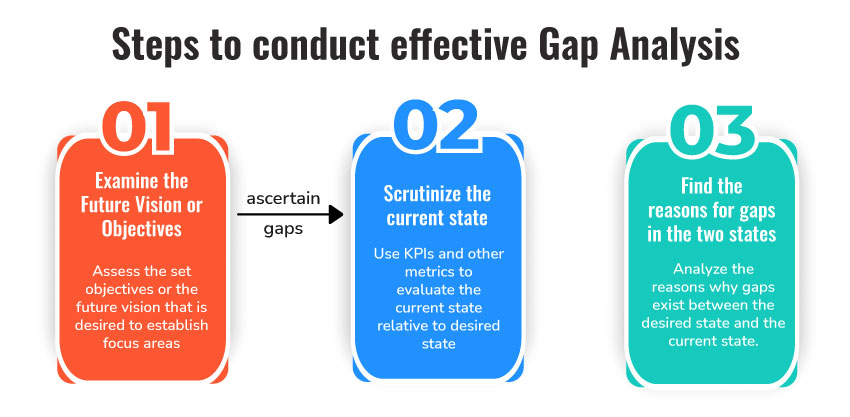
There can be two approaches to conducting a Gap Analysis subject to which aspect of the desired state we are looking at. As mentioned earlier, the desired state can either be about futuristic vision or can be synonymous with some well-defined objectives. So, with the view of making comprehension convenient, we will be explaining the process of conducting a Gap Analysis considering both cases separately.
Case 1: Gap Analysis corresponding to a futuristic vision
1. Examine the futuristic vision
This involves creating an outline of the future vision and the strategic goals that can be inspired from that vision. For a vision to succeed, it needs to translate into strategic goals and objectives. Having said that, the first step in carrying out a Gap Analysis for a futuristic vision is to visualize how things can change for the better and then identify the key results areas that need to be delivered.
For instance, if we look at the vision statement of NASA, it says that it aspires to discover and expand knowledge for the benefit of humanity.
Now, for NASA to make the most out of this vision, it needs to evaluate its vision time and again and align strategic plans and goals to this vision. Furthermore, it needs to visualize how this vision can add new dimensions to this world and what approaches will be the best to achieve it.
Assess the current state
After having thoroughly examined the future vision, the next key step in the process of a Gap Analysis is to scrutinize the current state. This will enable individuals, communities, or organizations to ascertain where the current state lies relative to the strategic plans and best practices coherent to what is envisaged for a better future.
An honest assessment of the present state will enable the identification of gaps between the current scenario and the future state that is inspired by a valuable vision. This is where progress can be tracked through various quantitative and qualitative measures. Besides, a clear idea of the extent of gaps will help in understanding what is left to be done for the vision to translate into reality.
To exemplify, when NASA runs a Gap Analysis on its future vision, it will be able to ascertain how successful it has been thus far to discover and expand knowledge. When it evaluates the current state relative to its futuristic goals and vision, it will be able to identify the gaps. For sure, there is a lot of knowledge that NASA still needs to discover in terms of finding clues of human life in outer space. The realization of the gaps may lead to new space missions initiated by NASA.
Find reasons for the gap
After the gaps have been recognized, the next measure is to ascertain the reasons behind the same. Ascertaining reasons for gaps is paramount to the cause of identifying the areas of improvement that need to be worked upon such that gaps can be bridged in an effective way. Besides, ascertaining the reasons for deficits between the current state and intended future vision is also essential to track the effectiveness of plans and actions executed so far.
To bridge the gaps, it is necessary to eliminate the reasons or factors that are responsible for the shortcomings. For that, all causes and their effects must be identified meticulously ensuring that no reason is overlooked.
For instance, why NASA has taken so long to recognize the traces of life on Mars is perhaps because quite a few Mars missions by NASA have failed. These failed missions include The Mars Climate Orbitor, Deep Space 2, and The Mars Polar Lander. These reasons are responsible for gaps in the knowledge of outer space that NASA has been able to gather so far relative to its vision.
Case 2: Gap Analysis corresponding to pre-defined objectives
1. Assess the objectives
In this case, rather than goals and objectives transcending from a future vision, objectives are already well defined and specific. Gap Analysis, in this case, begins with a comprehensive examination of the objectives. This will involve determining what the objectives aim to achieve in particular, how they can be tracked, and what are the key performance indicators linked to them. Also, a cause-and-effect relationship needs to be applied to each objective.
Organizations or individuals conducting a Gap Analysis should have proper clarity of what objectives they need to target. Besides, they need to be sure of what actions need to be taken for achieving these objectives. Simply put, there should be an effective, lucid, and concise understanding of the desired objectives to have a clear outline of the target state.
To exemplify, let’s say an individual has an objective of establishing a successful career in freelance web designing after leaving a full-time job he has been in for more than five years. Now if he decides to run a Gap Analysis on himself, he will first need to examine his objective and define the terms of success for himself. For some people, doing 20 projects a month may be a measure of success while for some, success may mean a mere 10 freelancing projects in web design.
He will have to establish the parameters of success for himself. He will need to examine his objective in terms of the number of clients and projects he is looking to serve as a freelancer. Besides, he needs to evaluate the ways in which he can win more clients and projects.
2. Examine the current state
After examining the objectives, an individual or organization then needs to examine their current state. Simply put, they need to track their objectives and see how far they have come in their objectives. A clear insight into the current state or the pace of progress will enable them to figure out the gaps relative to their desired objectives.
Moving further, in case they find out that their current actions are lagging behind their set objectives, they will also be able to find out the extent to which they need to fill the gaps to accomplish their objectives. The assessment of the current state can be enabled by measuring some key performance indicators.
For instance, augmenting the above example of the freelance web designer, an assessment of the current state will enable him to determine the number of clients and projects he has at present. Further, that will enable precise identification of the gap in the number of clients and present and the desired volume of clientele. Leads and the number of referrals can also be useful key performance indicators here.
3. Identify the reasons for gaps
Like in the case of futuristic vision, in this case too, finding the reasons for gaps in the pursuit of objectives is important to eliminate the factors asserting negative influence. The causes for gaps need to be identified, addressed, and alleviated.
It becomes quintessential to eradicate the reasons why the current progress of objectives is not aligned with the desired state. If these reasons are not addressed, the gaps between the current state and the desired state will tend to increase.
To illustrate, taking the above example ahead, if the freelance web designer is not able to attain the desired number of projects in web designing, it is imperative to find out the reasons for the same. For the web designer to meet his objectives, he needs to identify and address the reasons at the earliest. The more he overlooks these reasons the greater the losses will be. Lack of effective networking, skill gaps, or improper marketing can be some basic roadblocks in the success of freelancers.
What to do after the identification of gaps and reasons?
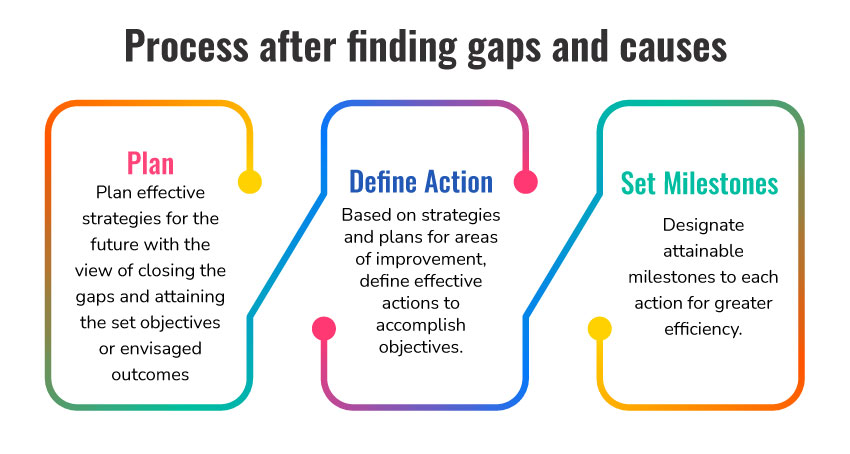
The true purpose of Gap Analysis is not limited to ascertaining gaps differentiating the present state and the desired state along with the reasons for the same. A Gap Analysis is rather meant to suggest action terms for improvement such that the gaps can be filled. Remember, Gap Analysis is more of an improvement tool than simply being a technique for tracking vision and objectives. Consequently, the following measures need to be taken once the anticipated state is examined, the current state is assessed and reasons for gaps are identified.
1. Planning
Every change management process starts with planning. After ascertaining the reasons why organizations or individuals are lagging behind in their objectives or vision, strategic planning needs to be undertaken. While one important component of planning must cater to the mitigation of reasons for poor performance, the other aspect of planning should be based on devising the roadmap ahead to reach the desired state. Individuals or organizations need to plan on compensating for the gaps in progress thus far so that the desired state can still be achieved in the stipulated time.
This planning will involve the following elements
- A thorough assessment of each identified reason for gaps
- Effective recognition of the areas of improvement
- Assessment of the present resources for acting on areas of improvement
2. Defining actions
Planning around the above elements will further pave the way for actions to be taken with immediate effect or in the due course of time such that the gaps can be filled. The actions need to be decisive in nature, specific to outcomes, and should be attainable. Like in the case of planning, actions too will need to be categorized into the following two classifications.
- Actions to annihilate the reasons for gaps
- Actions to optimize the progress to achieve the desired state
In the case of an individual, of course, all dimensions of accountability of actions will be coherent to one person. But in the context of unions or organizations, the accountability needs to be fixed at different levels with respect to the planned actions.
3. Setting milestones
Each planned action needs to be assigned a milestone for completion in the best interest of meeting the desired state in stipulated time. When deadlines are designated to actions, it makes actions more streamlined and they can be constantly tracked relative to time.
Moreover, deadlines or time frames make actions more specific in nature.
Needless to say, these time frames need to be coherent to the stipulated time that has been set to accomplish an objective or future vision. For instance, if an organization needs to achieve a specific objective in a span of two years, the milestone for each planned action must be well below two years such that all actions add to the successful completion of the objective. Companies need to set SMART Goals with respect to filling performance gaps and building competitive advantages.
Types of assessments in Gap Analysis
1. Individual Gap Analysis
This is one of the most common types of Gap Analysis. Individuals can carry out a Gap Analysis on themselves to find out if they are on the right path in terms of their current actions, skills, or achievements to meet the desired objectives. The same can be done by an individual to evaluate their progress linked to a futuristic vision.
For instance, a college student in the last year of post-graduation can conduct a Gap Analysis on himself to find the gaps between the current state and the desired state of employability objectives. Let’s say the student wishes to pursue a career in financial consultancy. Using Gap Analysis, the student can find out the gaps between the skills, knowledge, educational qualifications, and expertise the student currently holds and the prerequisites of a career in financial consultancy.
Furthermore, based on the realization of gaps, the student can take measures like enrolling for distance learning courses in finance or interning with a finance consultancy on the sidelines of academics to enhance the prospects of getting a job in financial consultancy after college.
2. Strategic Gap Analysis
A strategic Gap Analysis is another important form of Gap Analysis that can be used as a worthwhile tool for finding gaps between the actual performance and the expected performance. A strategic Gap Analysis assesses what has been achieved so far in terms of strategic implementation relative to the expected outcomes.
A strategic Gap Analysis is more commonly used by business organizations to determine the gaps between their strategic objectives and the current position. In other words, it is a technique using which they track the current progress of their strategic objectives and mission.
To exemplify, let’s say an electronics company has set the strategic objective of increasing its sales by 500 percent by the end of the current fiscal year. Now, a strategic Gap Analysis can help the company in determining the current rise in sales relative to the objective of the 500 percent increase by April 2022. Further, let’s say the metrics of sales suggest that the increase in sales thus far has only been 150 percent with only a few months left for the current fiscal year to end. Clearly, the company can identify the gap of 350 percent hike in sales from the results of the strategic Gap Analysis.
Furthermore, based on this identification of the gap and the causes for the same, the company can come up with new measures to push sales by 350 percent in the remaining time frame. The company can announce huge discounts, special offers, and appealing perks for buyers.
Moreover, the company can brainstorm new marketing campaigns like affiliate ads to target a specific audience. These could be some of the ways in which the company can boost sales and meet objectives. With a few months left for the fiscal year to end, the planning of actions and time frames needs to be highly effective.
3. Production Gap Analysis
A production Gap Analysis can be conducted by manufacturing units and production enterprises to ascertain the gap between the current rate of production and the desired rate of production. Gap Analysis, in this case, will enable a manufacturing company to assess its current production efficiency relative to the expected efficiency of the production objectives set by the company.
Needless to say, huge gaps between the number of units being produced currently and the number of units desired in a period of time will hint at low production efficiency in terms of the production objectives.
To cite an example, let’s say a company producing plywood set an objective of boosting its production efficiency by 110 percent at the beginning of the calendar year. So, if the company was producing 400,000 sheets of plywood until this year, a 110 percent increase would mean that it has set the objective of producing 4,40,000 sheets this year.
Now, when a company runs a Gap Analysis in September, it finds out that the production efficiency has only increased by 60 percent relative to the last year. This implies that there is a production gap of 50 percent between the current state of production and production objectives. Besides, a Gap Analysis will also render details of the reasons why production efficiency has been below par. Lack of manpower, inconsistent supply of softwood, or outdated equipment can be some plausible reasons for production gaps.
Moreover, based on the findings of the Gap Analysis, the company can initiate new plans and actions with a specific time frame to fill the gaps in production efficiency. The company can outsource production, hire more labor for uninterrupted production, and address inventory issues. With three months left to fill the production gap, every action will require a strict milestone.
4. Supply management Gap Analysis
As the term suggests, a supply management Gap Analysis is applied by business organizations to find out the gaps between the current volume of supply of raw materials or spare parts and the desired volume of supply. This will help the company to determine if it is being able to manage its supplies and inventory effectively enough to meet its production targets or not.
In simple terms, the supply management or supply chain gap refers to the deficit between the current supply chain performance and the supply chain performance a company desires in the future. The purpose of a Gap Analysis here would be to identify the supply chain gaps and eliminate them to drive maximum production efficiency.
To cite a real example, Ford was to launch the Sasquatch package manual transmission version of its latest car, Bronco in 2021. However, because of the supply chain disruptions in the automotive industry caused by the COVID-19 pandemic, the car will now be launched in 2022 as per Ford’s communications manager. Now that the pandemic has almost settled, a supply chain Gap Analysis will enable Ford to determine if its production line is well equipped to meet the objective of launching the Bronco Sasquatch manual transmission version in 2022.
Moreover, it will also help the company in assessing the gaps in the supply chain that need to be plugged to meet the massive demands of the current version of Bronco launched in 2020. It is interesting to note that the first editions of the car have been completely sold out and the demand for the car is absolutely high. Having said that, any disruptions in supply management can attract a heavy loss of reputation and sales for the company.
After finding the gaps in the current supply chain performance, Ford can identify the deficits that exist in the supply of different spare parts and also the reasons behind the same. Thereafter, the company can realize the areas of improvement and take timely actions to optimize the supply chain for the production of Bronco. Using IoT to track automotive spare parts, enhancing automotive parts visibility, and integrated supply chain platforms are some actions automotive companies can take to mitigate supply management gaps.
5. Product Gap Analysis
Product Gap Analysis is carried out by businesses to pin down the gaps in the current features of their products, the value proposition offered by their products, and the actual market needs coherent to customer expectations. The key here is to have great knowledge of market needs, the latest trends in customer preferences, and the most advanced features in the product segment. This can be achieved through robust market research and intelligible competitor analysis to carve a futuristic vision and set strategic objectives.
Once the vision for product features and value propositions is envisaged and objectives are set, companies can conduct a product Gap Analysis to identify the gaps between the current state and the desired state. Based on the gaps hence identified and the factors leading to gaps, companies can then take proactive measures to optimize their products and enhance their value proposition.
To exemplify, let us take the example of smartwatches here to understand how a product Gap Analysis can be beneficial. Let’s talk about some of the imperative expectations that consumers have from smartwatches. They want their smartwatches to be highly compatible with their phones, have all the essential fitness features, support long battery life and have app availability.
As we know, Apple is the leading brand when it comes to features of smartwatches and the value proposition offered to customers. As per Statista, while the market share of Apple in the global smartwatches market was 52.5 percent, the share of Samsung remained as low as 11 percent. In this scenario, with the strategic objective of competing with Apple watches, Samsung can conduct a product Gap Analysis to determine the features that Samsung smartwatches lack when compared to Apple smartwatches.
The product Gap Analysis will help Samsung to find the gaps between the current features offered by its smartwatches and the features that give a competitive advantage to Apple watches. For instance, the battery life of OS watches from the joint venture of Google and Samsung is known to be considerably low when compared to Apple watches. Moreover, while Apple watches are known to be excellent at tracking a wide range of fitness metrics, OS watches only track some standard fitness indicators. A Gap Analysis will help Samsung in focusing on these deficits in features.
Similarly, it can find out the gap between the value proposition offered by its watches and the actual value proposition that smartwatch buyers look forward to. Of course, Samsung enjoys the unique selling proposition of offering a wide range of products at competitive prices. However, in the context of the smartwatches market, Samsung will need to offer a greater value proposition to customers to be able to compete with Apple’s dominance.
Moving ahead, Samsung will be able to analyze the reasons why it has not been able to compete with Apple in the smartwatches market as it would have liked to. Subsequently, Samsung can plan new actions with corresponding time frames to meet its objective of gaining more share in the global smartwatch market. The actions can include the incorporation of more fitness features, the use of gestures for better accessibility, and making the most of its partnership with Google for technological brilliance. As stated earlier, there needs to be a milestone attached to each action.
In the upcoming section, let us look at some of the most commonly used and worthwhile tools that can be used to conduct a Gap Analysis. Depending on the purpose and the capacity in which a Gap Analysis is being conducted, one can choose from different tools.
Tools for conducting a Gap Analysis
1. SWOT

SWOT is a commonly used tool for the purpose of carrying out different analyses. The same tool can also be used by an organization or individual to conduct a Gap Analysis between the current state and target state. As many would already know, SWOT is an acronym for
- S: Strengths
- W: Weaknesses
- O: Opportunities
- T: Threats
How SWOT can be a perfect fit for Gap Analysis
An individual or organization can conduct a Gap Analysis by creating a SWOT analysis matrix wherein they can note down their strengths, weaknesses, opportunities, and threats. While the abstracts of strengths and weaknesses will relate to their internal competencies, opportunities and threats will be more relevant to the external environment. Thereafter, they can examine their current state and the state of desired objectives or visionary outcomes to identify the gaps. An assessment of weaknesses and threats will hint at the reasons for the gap in the two states. Weaknesses will be synonymous with the factors for the existing shortcomings.
Going forward, they can then analyze how they can put their strengths to effective use to mitigate the weaknesses and bridge the gaps between the current state and target state. Similarly, the realization and assessment of opportunities will lead them to plan actions for allaying threats. Subsequently, they would have a precise idea of the reasons for gaps and what measures they can take in coherence with their strengths and opportunities to fill the gaps.
Let us further understand the applicability of SWOT in conducting a Gap Analysis through a relevant example. Let’s say a political party that is currently in opposition has the objective of gaining more than 40 percent vote share in the general elections next year to form the government. Now, the party’s president and conveners can run a Gap Analysis using SWOT to evaluate the gap between their present political campaigns and the prerequisites for attaining the desired vote share. Let’s say the party conducts a survey according to which it is expected to win only 20 percent of the vote share hence implying an almost 20 percent gap relative to the target objective.
Further, the party can use a SWOT matrix to analyze the reasons for the identified gap and create a plan of action to plug the gap. The party can run an assessment of its strengths, weaknesses, opportunities, and threats. Speaking of the weaknesses, let’s say the reasons for gaps include lack of young leadership, conservative ideology, and history of corruption charges on party leaders. These could be substantial reasons why a massive gap exists between the present state and the target state. Speaking of threats, newly emerging parties with young leaders and social liberation in the civil society can be massive threats for the conservative party.
Now, that the party has identified the weaknesses and potential threats, it can create a firm action plan to close the gap. This is where the strengths and opportunities will come into play. Let’s say the party’s greatest strength lies in the massive experience of its leaders, the ability to create sentiments of nationalism, and good connectivity with people both on social media and the ground level. So, the party can create aggressive social media and offline campaigns around nationalism to build momentum and present itself as a true nationalist as opposed to others.
Moreover, it can create campaigns highlighting the public life achievements of its seasoned leaders. These strengths can help the party overcome its weaknesses.
Speaking of opportunities, anti-incumbency against the present government, lack of experience among new parties, COVID mishandling by the current government can be some great opportunities the party can capitalize on to meet the desired vote share.
2. PESTEL
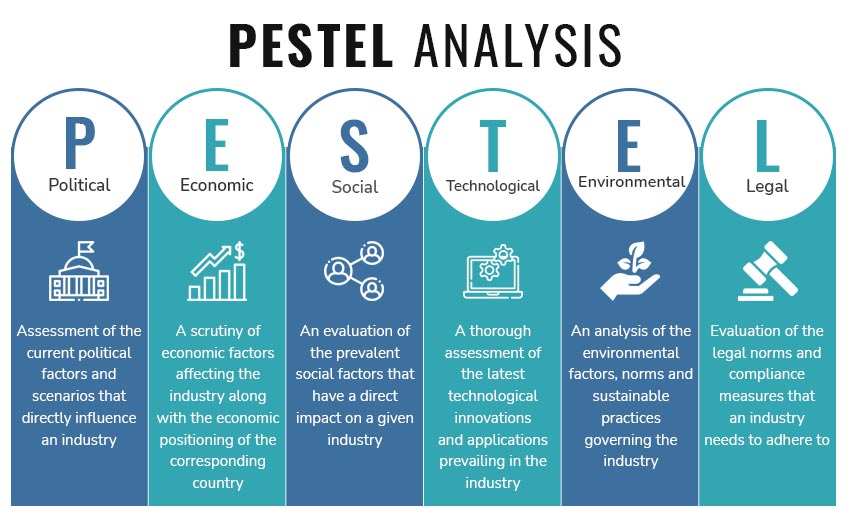
PESTEL Analysis (Also known as PESTLE Analysis) is an extensively used tool that can be implemented to examine the impact of external factors on an organization or industry in the usual sense. These external factors include political, economic, social, technological, environmental, and legal, hence the acronym PESTEL.
How PESTEL can be a perfect fit for Gap Analysis
In a given industry, the PESTEL tool can be used by companies to assess reasons for deficits in the current state and the desired state. Furthermore, the companies can work on creating revival strategies and future plans of action based on the inferences drawn from the effective use of PESTEL. An effective analysis of the PESTEL factors basically yields an overview of the threats and opportunities in the external business environment that are crucial for a company to know. While the identification of threats will lead to the further realization of the causes for gaps, opportunities will inspire corrective actions.
Besides the internal competencies of a business, the external factors in the business environment too are of great importance for business continuity and growth. The unprecedented COVID-19 pandemic is one of the most realistic examples of how external factors affect businesses.
Let us take an example here to comprehend things with more clarity. Let’s say a company has been facing constant shortfalls in the supply chain affecting the production line of the company and hence hitting profitability. Now, the company can conduct a Gap Analysis based on the PESTEL factors to ascertain the causes for disruptions in the supply chain leading to lesser production efficiency. It can evaluate how each of the external factors included in the PESTEL tool affects the supply chain.
Moreover, it can then create a plan of action for the future in coherence with these factors to meet its objective.
The greatest factors affecting the supply chain could be the economic and social factors largely affected by the ongoing COVID-19 pandemic. The economic setbacks caused by COVID-19 leading to the downfall in the production of raw materials or spare parts can be directly responsible. Similarly, lack of labor during the times of COVID-19 and the healthy emergency this caused can be the social factors directly responsible. Besides, the ignorance of the need for machinery upgrades in the industry could be a technological factor adding to the gap.
Political factors like the closure of borders in the pandemic impacting international trade can also be responsible. To add, rampant depletion of natural resources can be a vital environmental factor playing its role here. Also, stringent laws on the supply management of hazardous substances can be legal factors affecting the supply chain.
Next, having realized the reasons for the gap emerging from PESTEL factors, the company can look to create a roadmap for the future. Government stimulus packages for the industry and subsidies on supplies can be crucial political factors influencing future actions. Similarly, the revival of GDP and trade in the post-pandemic era can be an important economic factor. To add, new technological innovations undergoing trial runs in the industry can also be a significant technological factor on which future measures can be based.
Speaking of the future actions, the company can decide to invest in the R&D of the new supply chain technologies that have undergone successful trials in the industry can be an effective measure. To add, procuring raw materials or spare parts from countries the government is fostering new trade relations with can be a good tactic. Also, speaking of the social scenario, with more and more people now being fully vaccinated, more labor can be employees in supply chain management.
3. Nadler-Tushman Model
Nadler-Tushman Model is a dynamic tool that is used mostly in the context of business organizations to pinpoint the gaps in the current state and planned objectives. Also, it can effectively assess the factors leading to gaps. Under this model, the operational processes within an organization are bifurcated into the following three categories.
- Input: includes the human capital, company culture, and deployment of resources
- Transformation: Inclusive of the systems and processes that transform the input into output
- Output: Includes the finished products, services, and results
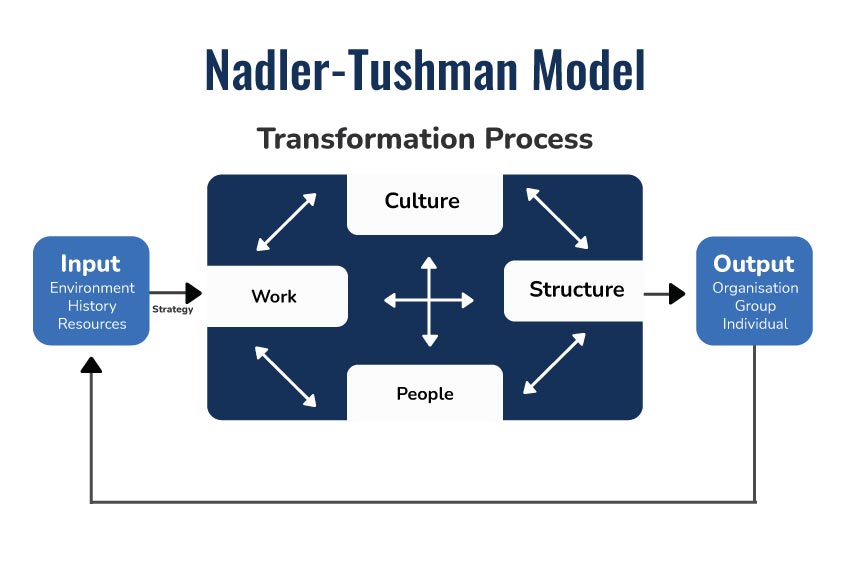
How the Nadler-Tushman model can be a perfect fit for Gap Analysis
A division of organizational processes in the above three classifications facilitates close supervision at each step. It takes into account the amount of input going in and the intricacies of transformation that convert input into the final results. Therefore, under this model, the output is assessed relative to the input and the gaps between the current output and the desired output are realized. These gaps may exist in the context of input or transformation. Furthermore, effective actions can be planned to overhaul input or transformational processes to accomplish the aspired output.
Let’s take an example here. Let’s say the sales department in a particular branch of a private bank has 10 people with the set targets of opening 50 new bank accounts in every quarter. The input in this case from the purview of human capital is 10 and as per the above scenario, the branch should be able to open 500 accounts every quarter. However, it turns out that the average number of new accounts in every quarter is below 300.
Clearly, there is a gap of more than 200 accounts in the current output and the expected output. Now, Gap Analysis with a streamlined focus on input, transformation, and output can be of great help here. First, reasons for gaps pertaining to the input can be evaluated. If more people are needed in the sales vertical, the work environment is favorable and if the products offered by the bank are good enough to prosper in the market are going to be some major considerations here.
Next, the causes of gaps can be evaluated from the viewpoint of transformations. If employees are motivated, employee engagement is high and employees have the right skills to pitch products or not can be examined. Thereafter, if the sales head is accountable and is able to get the most out of his or her team will be another vital factor in transformation.
Consequently, keeping in mind the dimensions of input and transformation, new plans of action with milestones can be thought of. The bank can employ more people in the sales department of the branch. The heads of departments along with the branch head can think of new employee engagement strategies and find ways to make the work environment more inspiring. Besides, the bank can announce attractive monetary incentives for salespeople on meeting their targets.
4. Fishbone Framework/cause and effect tool
The Fishbone Framework, also known as the cause and effect model, aims to discover and scrutinize the key causes of a specific problem along with the effect of every cause on the ideal outcome. Different spectrums of factors can be taken into consideration while identifying the causes of a problem using the Fishbone Framework.
Some common sets of factors that are used by businesses to run a Gap Analysis include the 5Ms in manufacturing, 8Ps in product marketing. After dividing a process into various parameters, the causes of problems and their effects are closely examined.
How the Fishbone Framework can be a perfect fit for Gap Analysis
The cause and effect relationship or the Fishbone Diagram is one of the most ideal tools for the examination of the current state that happens to be one of the vital objectives of Gap Analysis. Based on the relevant internal factors, it can be an effective tool for gauging the current state and identifying the root causes of the gaps between the current state and the desired state. Consequently, knowing the causes for below-par performance, stringent actions can be planned for the future.
Each factor taken into account acts as a different branch of the Fishbone Framework. The diagram thus presents a concise overview of the existing causes of problems in the current state via visualization. In this way, even the most complicated gaps between the current state and the ideal state can be understood and acted upon.
Let’s take a relevant example here aligned to the 8Ps of product marketing. These 8 factors linked to product marketing include product, promotion, price, people, process, place, philosophy, and physical evidence.In case a company is not able to drive the expected sales and generate enough leads, it can run a Gap Analysis on its present marketing strategies. The top management of the company along with the top marketers can assess the 8Ps of marketing relative to the following considerations.
- Product: If the product has all the features that can attract potential customers and intrigue buyers with its unique selling propositions
- Promotion: If the current tactics of marketing and promotion including social media promotion, content marketing, digital ad campaigns like PPC, influencer marketing, and video marketing have been able to create a buzz about the product. Public relations also come into the picture here.
- Price: If the price is competitive and is able to attract more customers than the competitors. The price directly relates to the value proposition offered along with the product.
- Place: If the right places and channels have been identified for making the product available to the customers.
- People: If people responsible for the launch of products and services and creating promotional campaigns for the same are working effectively and delivering on what is expected of them.
- Physical evidence: Physical evidence basically relates to the packaging of products. If the company’s packaging is engaging and appealing or not needs to be evaluated here. This is where the virtual unboxing of smartphones and tablets serves as excellent examples of physical evidence.
- Process: If the company is able to offer cherishable and pleasant experiences to customers. Customized service, going the extra mile for customers’ happiness, and offering great value to customers are vital here.
- Philosophy: If the company is able to express its core values, mission, and vision to its customers in an effective way.
It is important to examine here how the cause and effect relationship is going to work in relation to this example. While the company has objectives of high sales, not being able to drive the same is a problem that needs to be addressed. To put it the other way around, the gap between the actual sales and the forecasted sales needs to be addressed. Now as identified in this example, ineffective marketing can be one of the causes of low sales.
Further, inefficient implementation of the latest SEO techniques can be the cause of marketing failures. Probing ahead, not having an SEO specialist with vast experience can be the cause for SEO campaigns yielding little or no success. This is how the nexus of causes and effects will work in this context. Similarly, causes of ineffectiveness in other marketing verticals in the 8Ps of product marketing will add to the other causes of the problem statement.
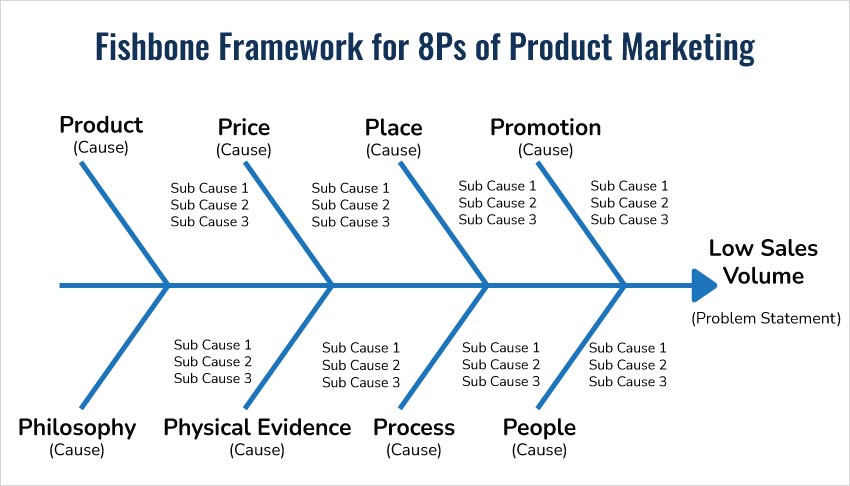
Therefore, as cited above, with a Fishbone Framework, the current state pertaining to the above verticals can be examined effectively and the causes for problem statements or gaps can be realized. Thereafter, tweaks and new actions with milestones can be initiated across all verticals where performance problems exist. To name some of the actions, the company can launch new digital marketing campaigns, overhaul its content marketing strategy, associate with more social media influencers and initiate storytelling marketing campaigns. Besides, the company can improve product features or launch new variants of the existing products in the market with specialized features.
Moreover, the company can look to have a more competitive pricing strategy. Also, it can initiate virtual customer onboarding and improve customer service metrics to improve processes. This is how an analysis based on internal factors under the Fishbone Framework can enable an organization to identify gaps, understand the causes and their effect and come up with remedial solutions. At last, it can also decide what it can do to optimize the performance of its people at the helm of marketing campaigns or if new people need to be hired in marketing.
5. McKinsey 7S Model
This highly useful tool was developed by two consultants at McKinsey during the 1970s to help business organizations undertake effective change management and achievement of business objectives. As the name suggests, the model sheds light on seven S’s that form imperative verticals of an organization and its functioning. The model divides these seven S’s into two categorizations: Hard S and Soft S.
The elements of Hard S under the model include the following.
- Structure
- Strategy
- Systems
On the other hand, the elements of Soft S under the McKinsey 7S Model include the following
- Shared Values
- Skills
- Style
- Staff
Thus, the model enables a business organization to divide its functioning and operations across the above seven verticals to individually evaluate each of them and create a roadmap for the future. It is noteworthy that this model lays the maximum emphasis on shared values and puts them at the center of the model with other elements surrounding it.
How the McKinsey 7S Model can be a perfect fit for Gap Analysis
Dividing the functionalities of an organization into the above seven vital elements can facilitate a more refined and efficient examination of the expected future state of these elements. Thereafter, across the same verticals, a credible examination of the current state can be done that will help in pinpointing the gaps between the two states. Furthermore, specific reasons for gaps in each vertical can be learned and specific actionable recommendations and measures can be planned and implemented.
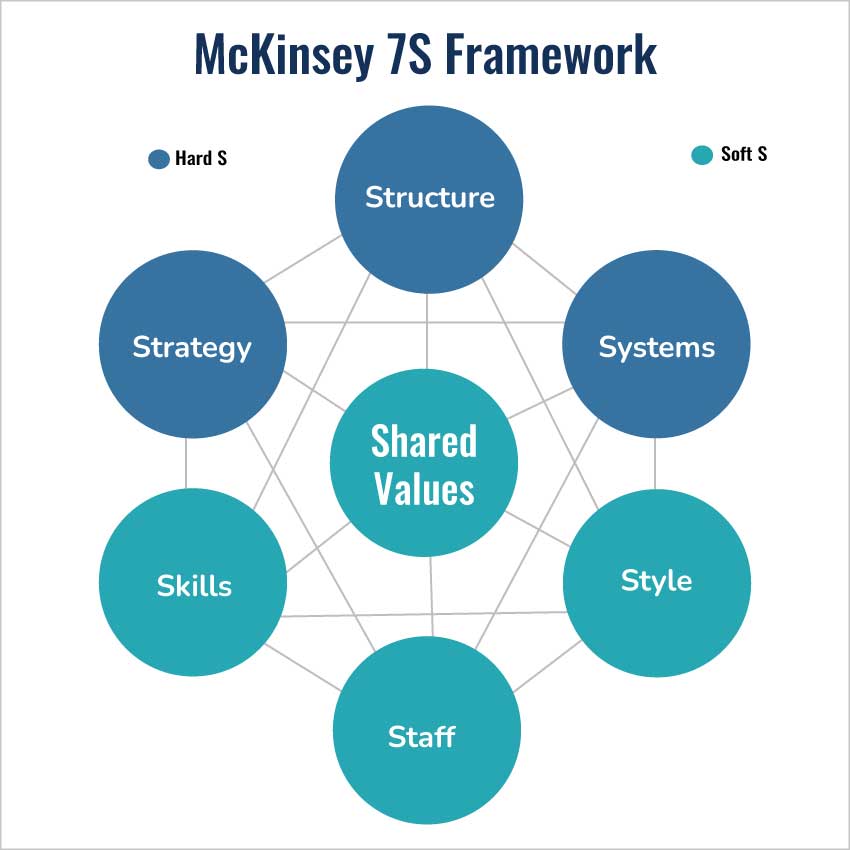
Let’s take an example here to see how the McKinsey 7S model can be used for conducting a Gap Analysis. Let’s say a business organization has the objective of increasing its staff to 1000 employees within a year. Simultaneously, it wants to ensure via training that all its existing and new employees develop impressive soft skills with special emphasis on communication proficiency. Another key objective of the company is to double its revenue within two years.
To begin with, the company can first divide its functioning into the 7 elements of the McKinsey 7S model. As per the above objectives, the greater focus would be on strategy for revenue growth, skills, and staff with other elements having their impact on each other and these three. Examining the current state after this division will facilitate a clear understanding of gaps.
The current revenue will help in identifying the gaps in the objective of increasing revenue two-fold. Similarly, the current strength of the workforce will lead to the identification of the gap in the desired number of employees. Lastly, an evaluation of the current proficiency of employees in soft skills will help in determining the gap in the desired skill development.
After the gaps between the current state and desired state are identified, the next task would be to underline the causes and the potential areas of improvement across each vertical. Consequently, planned actions with time frames can be decided to fill the gaps such that the organization succeeds in its objectives. For instance, to reach the desired number of employees, company culture can be improved. Also, job vacancies can be marketed on social media and on the internet with affiliate advertisements.
Moreover, the company can be open to walk-in interviews to attract more candidates.
As for the objective of soft skills development, the company can invest in Learning Management Systems, have mentoring programs, and hold webinars and seminars on soft skills. The company can also hire a soft skills trainer to train employees. Moving forward, to double the revenues, the company can bring more refinements in its product, pricing, and promotional strategies. Investing in PPC or selling directly via social media can be some promising actions to increase revenues. The company can also think on the lines of mergers and acquisitions to increase its market share.
Although the focus here will be on staff, skills, and strategy, other elements will have their own importance at every step. Shared values, style, and systems will work in conjunction with other verticals to ultimately lead a company to the fulfillment of its objectives.
The ensuing section presents some ready-to-use templates for carrying out a Gap Analysis. Let’s have a look at how a Gap Analysis is practically done.
Gap Analysis Template
The Gap Analysis template helps to visualize the difference between the target plan and the real situation of the individual or organization. Till now, you must have got the idea that Gap Analysis helps the individual or organization to visualize its performance and determine where they are struggling. In this blog, we see that the Gap Analysis can be done for some specific individual, department, product, supply chain, and other domains. But, do you know what template can be used by the business organization to perform a Gap Analysis? There is no specific template for Gap Analysis but the organization can still use some predefined templates to evaluate and compare its performance.
General Gap Analysis template
The general Gap Analysis template can be used by an individual or an organization to assess their current performance against the set objectives or future vision. In this template, the individual needs to fill in the data relating to the objective or future vision, current state, gap between current and future Position, reasons for gaps, and remedial actions to be taken in a set timeframe.

For instance, Varun, a sociology student, aims to become a social service manager after completing the Online Master of Social Work (MSW) course. However, he believes that having a degree is not enough to attain a leading position. For this, he can undertake the Gap Analysis to assess his current state and determine the actions to be adopted.

Individual Gap Analysis template
Individual Gap Analysis can help the individual to evaluate the individual performance. In the individual Gap Analysis, there is a need to fill the objectives, existing skills and competencies, gaps, actions to improve, and timeline. The template for the individual Gap Analysis is shown as follows-

Using the above template, the student aiming to become a restaurant manager after completing his hospitality management course can conduct the Gap Analysis.

Strategic Gap Analysis template
Strategic Gap Analysis looks at the existing strategies of the company and benchmarking organization strategies with the competitor strategies. The strategic Gap Analysis template can help the organization to analyze the strategic gap. In the strategic Gap Analysis template, the organization can fill its Key Business objectives or future vision, current strategic state, gap, reasons for performance gap, action, and timeframe.
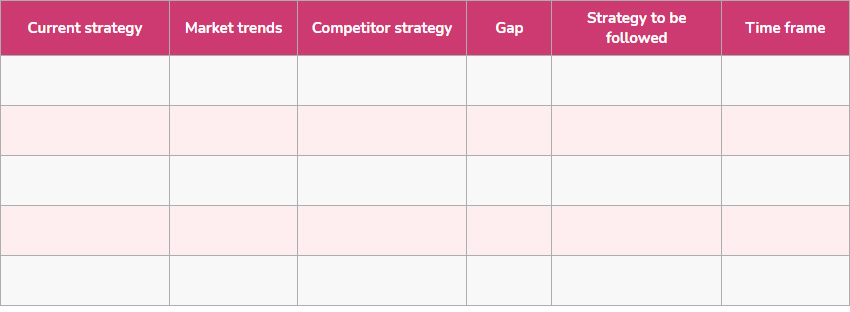
The strategic Gap Analysis template also includes the time frame for different strategies. Let’s say, an airline company aims to establish a 30% market share in the airline industry but the company currently uses the market penetration strategy. To identify the gap, the strategic Gap Analysis template is used as follows-

Productivity Gap Analysis
The organization can also use the productivity Gap Analysis template to provide visualization on the overall level of productivity of the organization. In the productivity Gap Analysis template, the organization can fill in the business and product type, strategic goal, desired level of productivity, current level of productivity, gap, strategic action, person responsible and time frame.
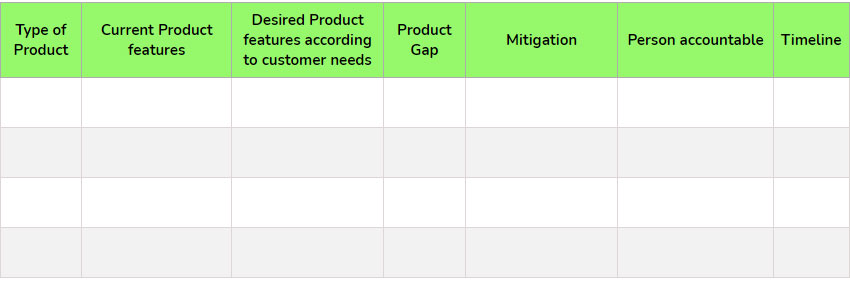
For instance, the manufacturing company is involved in the manufacturing of smartphones, the company can analyze the productivity Gap Analysis template in the following way-
Supply management Gap Analysis template
The organization can use the supply management Gap Analysis template to identify reasons for the shortage of raw material for production. In the supply management Gap Analysis template, the organization is required to fill in the information regarding the performance targets, delivery time, inventory turnover rate, Lead time, and quality.
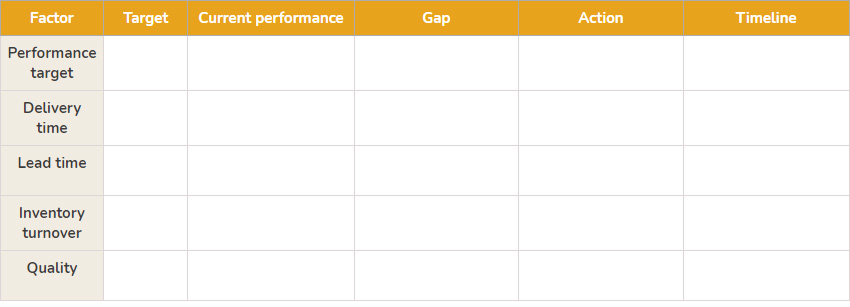
The use of this template can help the organization to deal with various Supply chain issues and challenges. Let’s illustrate the use of this template through an example-
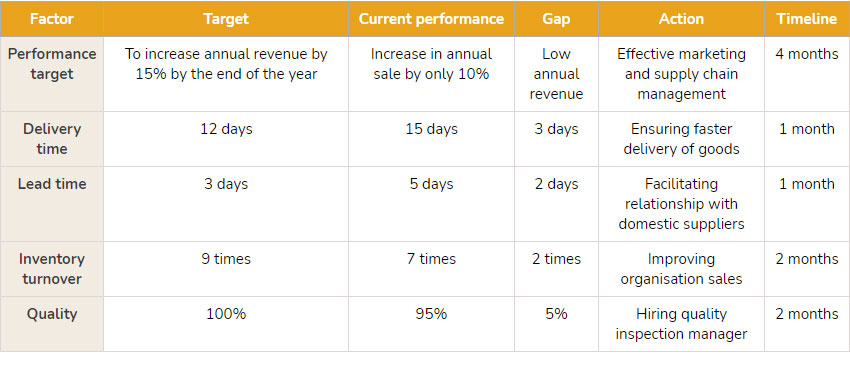
Product feature Gap Analysis template
The product feature Gap Analysis can help to evaluate the targeted features in the product and the current performance of the product. In the product Gap Analysis, the organization can fill in information about the current state, desired features in the product, gap, mitigation strategy, Person accountable and time frame.
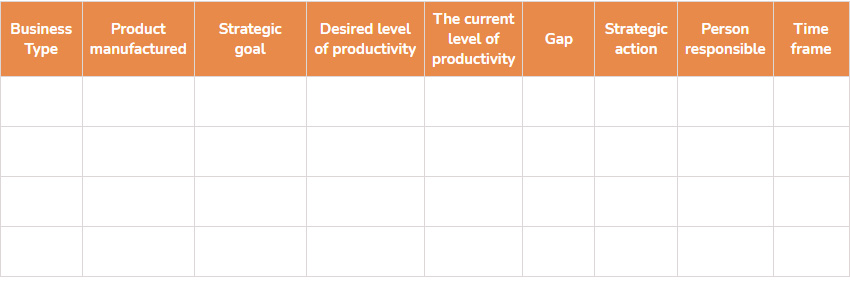
The smartphone manufacturing company can use this template to evaluate the product feature gap.



